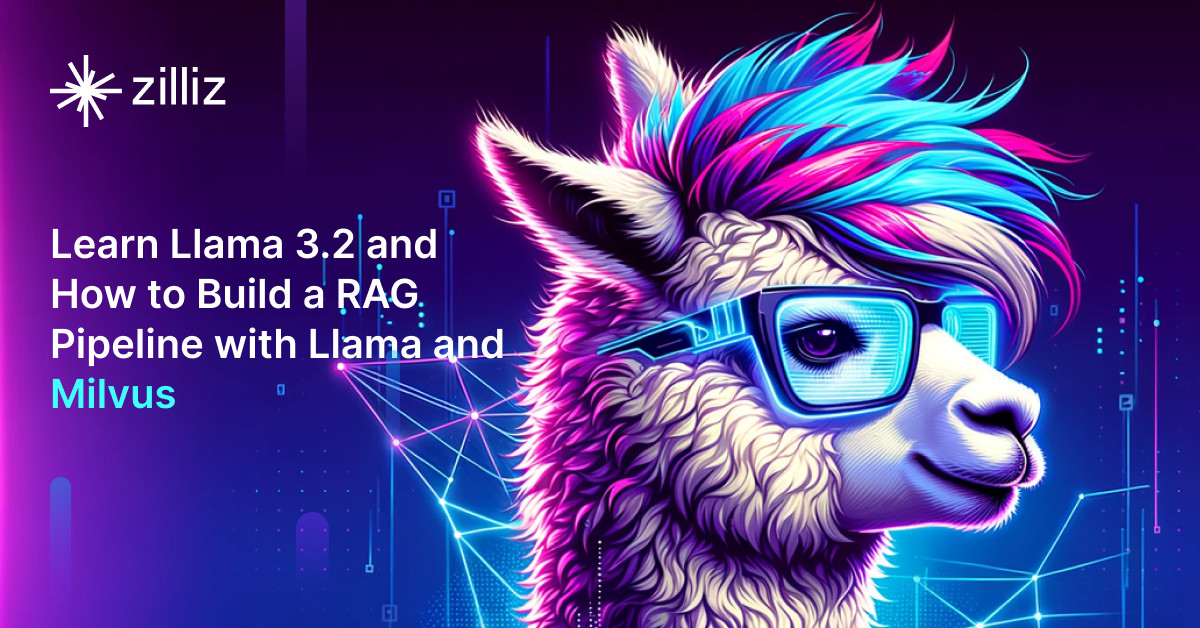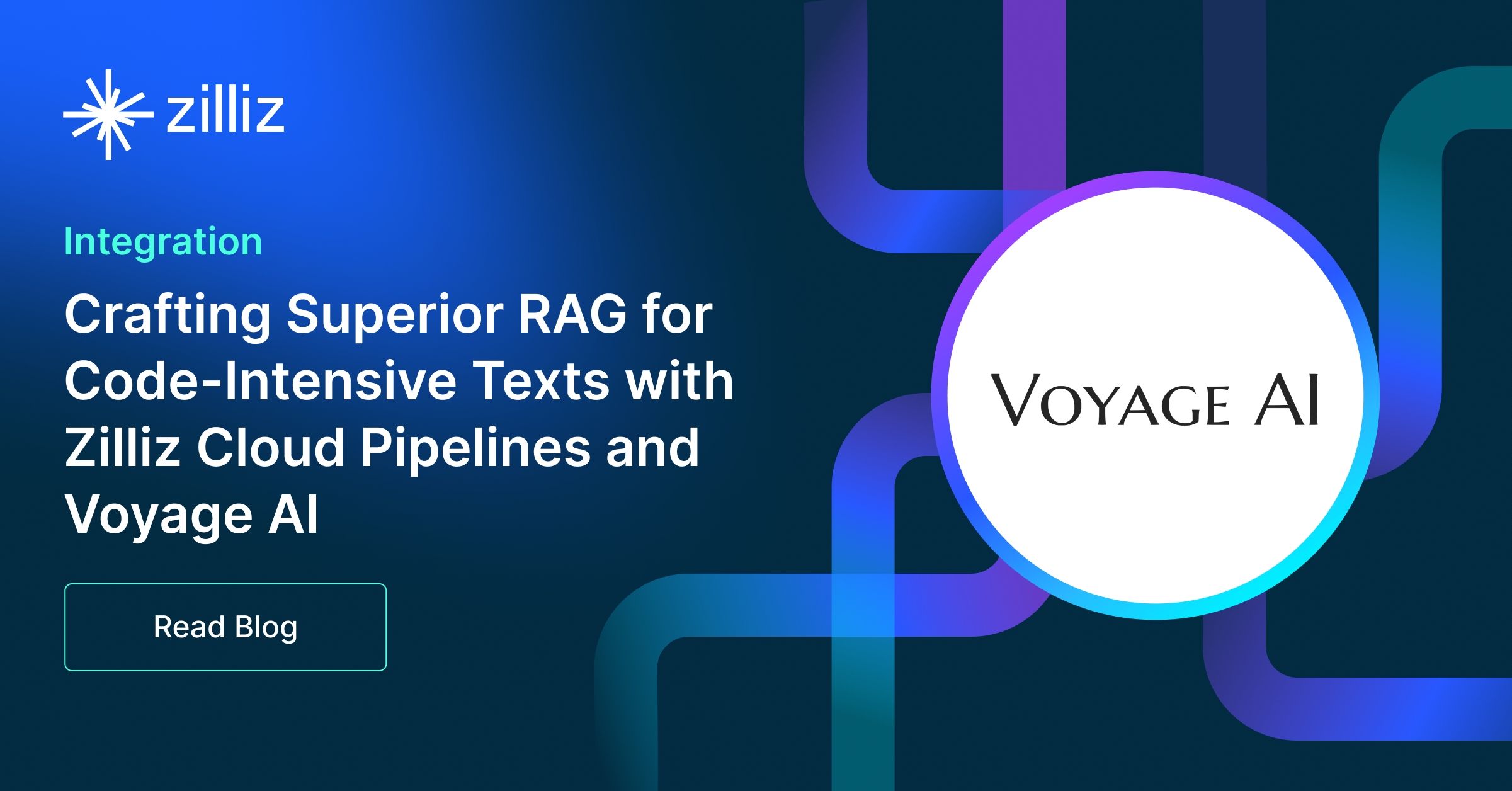Build RAG Chatbot with LangChain, LangChain vector store, Anthropic Claude 3 Sonnet, and Cohere embed-english-v3.0
Introduction to RAG
Retrieval-Augmented Generation (RAG) is a game-changer for GenAI applications, especially in conversational AI. It combines the power of pre-trained large language models (LLMs) like OpenAI’s GPT with external knowledge sources stored in vector databases such as Milvus and Zilliz Cloud, allowing for more accurate, contextually relevant, and up-to-date response generation. A RAG pipeline usually consists of four basic components: a vector database, an embedding model, an LLM, and a framework.
Key Components We'll Use for This RAG Chatbot
This tutorial shows you how to build a simple RAG chatbot in Python using the following components:
- LangChain: An open-source framework that helps you orchestrate the interaction between LLMs, vector stores, embedding models, etc, making it easier to integrate a RAG pipeline.
- LangChain in-memory vector store: an in-memory, ephemeral vector store that stores embeddings in-memory and does an exact, linear search for the most similar embeddings. The default similarity metric is cosine similarity, but can be changed to any of the similarity metrics supported by ml-distance. It is intended for demos and does not yet support ids or deletion. (If you want a much more scalable solution for your apps or even enterprise projects, we recommend using Zilliz Cloud, which is a fully managed vector database service built on the open-source Milvusand offers a free tier supporting up to 1 million vectors.)
- Anthropic Claude 3 Sonnet: This advanced model in the Claude 3 lineup specializes in creative and nuanced text generation. With a deep understanding of context and tone, it is well-suited for applications in creative writing, dialogue generation, and storytelling. Its ability to produce articulate and engaging prose makes it ideal for content creation and entertainment.
- Cohere embed-english-v3.0: This model specializes in generating high-quality text embeddings for English language input. It is designed for tasks like semantic search, recommendation systems, and document similarity, providing robust performance due to its deep contextual understanding. Ideal for applications needing nuanced language comprehension and efficient information retrieval.
By the end of this tutorial, you’ll have a functional chatbot capable of answering questions based on a custom knowledge base.
Note: Since we may use proprietary models in our tutorials, make sure you have the required API key beforehand.
Step 1: Install and Set Up LangChain
%pip install --quiet --upgrade langchain-text-splitters langchain-community langgraph
Step 2: Install and Set Up Anthropic Claude 3 Sonnet
pip install -qU "langchain[anthropic]"
import getpass
import os
if not os.environ.get("ANTHROPIC_API_KEY"):
os.environ["ANTHROPIC_API_KEY"] = getpass.getpass("Enter API key for Anthropic: ")
from langchain.chat_models import init_chat_model
llm = init_chat_model("claude-3-sonnet-20240229", model_provider="anthropic")
Step 3: Install and Set Up Cohere embed-english-v3.0
pip install -qU langchain-cohere
import getpass
import os
if not os.environ.get("COHERE_API_KEY"):
os.environ["COHERE_API_KEY"] = getpass.getpass("Enter API key for Cohere: ")
from langchain_cohere import CohereEmbeddings
embeddings = CohereEmbeddings(model="embed-english-v3.0")
Step 4: Install and Set Up LangChain vector store
pip install -qU langchain-core
from langchain_core.vectorstores import InMemoryVectorStore
vector_store = InMemoryVectorStore(embeddings)
Step 5: Build a RAG Chatbot
Now that you’ve set up all components, let’s start to build a simple chatbot. We’ll use the Milvus introduction doc as a private knowledge base. You can replace it with your own dataset to customize your RAG chatbot.
import bs4
from langchain import hub
from langchain_community.document_loaders import WebBaseLoader
from langchain_core.documents import Document
from langchain_text_splitters import RecursiveCharacterTextSplitter
from langgraph.graph import START, StateGraph
from typing_extensions import List, TypedDict
# Load and chunk contents of the blog
loader = WebBaseLoader(
web_paths=("https://milvus.io/docs/overview.md",),
bs_kwargs=dict(
parse_only=bs4.SoupStrainer(
class_=("doc-style doc-post-content")
)
),
)
docs = loader.load()
text_splitter = RecursiveCharacterTextSplitter(chunk_size=1000, chunk_overlap=200)
all_splits = text_splitter.split_documents(docs)
# Index chunks
_ = vector_store.add_documents(documents=all_splits)
# Define prompt for question-answering
prompt = hub.pull("rlm/rag-prompt")
# Define state for application
class State(TypedDict):
question: str
context: List[Document]
answer: str
# Define application steps
def retrieve(state: State):
retrieved_docs = vector_store.similarity_search(state["question"])
return {"context": retrieved_docs}
def generate(state: State):
docs_content = "\n\n".join(doc.page_content for doc in state["context"])
messages = prompt.invoke({"question": state["question"], "context": docs_content})
response = llm.invoke(messages)
return {"answer": response.content}
# Compile application and test
graph_builder = StateGraph(State).add_sequence([retrieve, generate])
graph_builder.add_edge(START, "retrieve")
graph = graph_builder.compile()
Test the Chatbot
Yeah! You've built your own chatbot. Let's ask the chatbot a question.
response = graph.invoke({"question": "What data types does Milvus support?"})
print(response["answer"])
Example Output
Milvus supports various data types including sparse vectors, binary vectors, JSON, and arrays. Additionally, it handles common numerical and character types, making it versatile for different data modeling needs. This allows users to manage unstructured or multi-modal data efficiently.
Optimization Tips
As you build your RAG system, optimization is key to ensuring peak performance and efficiency. While setting up the components is an essential first step, fine-tuning each one will help you create a solution that works even better and scales seamlessly. In this section, we’ll share some practical tips for optimizing all these components, giving you the edge to build smarter, faster, and more responsive RAG applications.
LangChain optimization tips
To optimize LangChain, focus on minimizing redundant operations in your workflow by structuring your chains and agents efficiently. Use caching to avoid repeated computations, speeding up your system, and experiment with modular design to ensure that components like models or databases can be easily swapped out. This will provide both flexibility and efficiency, allowing you to quickly scale your system without unnecessary delays or complications.
LangChain in-memory vector store optimization tips
LangChain in-memory vector store is just an ephemeral vector store that stores embeddings in-memory and does an exact, linear search for the most similar embeddings. It has very limited features and is only intended for demos. If you plan to build a functional or even production-level solution, we recommend using Zilliz Cloud, which is a fully managed vector database service built on the open-source Milvus and offers a free tier supporting up to 1 million vectors.)
Anthropic Claude 3 Sonnet optimization tips
Claude 3 Sonnet provides a balance between speed and accuracy, making it a versatile choice for RAG systems. Optimize retrieval efficiency by limiting the number of retrieved documents per query to avoid excessive context window usage, which can slow down response times. Use semantic chunking techniques to break documents into meaningful sections, ensuring that only the most relevant information is passed to the model. Adjust temperature and sampling parameters dynamically based on the complexity of user queries, with lower values for factual responses and higher values when generating creative text. Implement structured prompting to guide the model toward more precise answers, reducing ambiguity in responses. If integrating multiple models, use Sonnet as an intermediate option for moderately complex queries while reserving Opus for high-stakes reasoning tasks. Utilize Claude’s API optimizations, such as streaming, to enhance response time and system efficiency.
Cohere embed-english-v3.0 optimization tips
Cohere embed-english-v3.0 is a robust embedding model tailored for English language text. To optimize retrieval, preprocess input text to eliminate irrelevant noise and focus on key terms or phrases that will drive relevant matches. Use approximate nearest neighbor (ANN) algorithms like HNSW for efficient retrieval in large-scale datasets. For resource management, employ dimensionality reduction or quantization techniques to compress embeddings, reducing storage requirements without sacrificing too much performance. Implement multi-threading for batch processing to accelerate embedding generation. Use caching to store frequently accessed embeddings and reduce redundant computations. Fine-tune the model on specific data to improve performance on domain-specific queries and ensure greater relevance in retrieval.
By implementing these tips across your components, you'll be able to enhance the performance and functionality of your RAG system, ensuring it’s optimized for both speed and accuracy. Keep testing, iterating, and refining your setup to stay ahead in the ever-evolving world of AI development.
RAG Cost Calculator: A Free Tool to Calculate Your Cost in Seconds
Estimating the cost of a Retrieval-Augmented Generation (RAG) pipeline involves analyzing expenses across vector storage, compute resources, and API usage. Key cost drivers include vector database queries, embedding generation, and LLM inference.
RAG Cost Calculator is a free tool that quickly estimates the cost of building a RAG pipeline, including chunking, embedding, vector storage/search, and LLM generation. It also helps you identify cost-saving opportunities and achieve up to 10x cost reduction on vector databases with the serverless option.
 Calculate your RAG cost
Calculate your RAG cost
What Have You Learned?
Wow! What a journey this has been! Together, we've explored the fantastic integration of a powerful framework, a sophisticated vector database, a cutting-edge LLM, and an advanced embedding model to create a state-of-the-art Retrieval-Augmented Generation (RAG) system. You’ve learned how the LangChain framework serves as the glue that seamlessly binds all these components, enabling you to build dynamic applications with ease. The LangChain vector store empowers you to perform lightning-fast searches, making your applications not only efficient but also incredibly responsive.
We dived into the world of Anthropic Claude 3 Sonnet, illustrating how this LLM brings a new level of conversational intelligence to your projects. It can understand context and generate human-like responses, enhancing user interaction significantly. Additionally, the Cohere embed-english-v3.0 model provided us with rich semantic embeddings, enabling us to represent your data in a way that captures nuanced meanings and relationships.
Remember those optimization tips and the free cost calculator? They are valuable tools for maximizing your RAG system's performance while keeping an eye on costs.
So, what’s next? The world of RAG applications is at your fingertips! Dive in, start building, optimize your systems, and let your imagination run wild. Your innovative applications are just waiting to be brought to life! Go ahead and make it happen!
Further Resources
🌟 In addition to this RAG tutorial, unleash your full potential with these incredible resources to level up your RAG skills.
- How to Build a Multimodal RAG | Documentation
- How to Enhance the Performance of Your RAG Pipeline
- Graph RAG with Milvus | Documentation
- How to Evaluate RAG Applications - Zilliz Learn
- Generative AI Resource Hub | Zilliz
We'd Love to Hear What You Think!
We’d love to hear your thoughts! 🌟 Leave your questions or comments below or join our vibrant Milvus Discord community to share your experiences, ask questions, or connect with thousands of AI enthusiasts. Your journey matters to us!
If you like this tutorial, show your support by giving our Milvus GitHub repo a star ⭐—it means the world to us and inspires us to keep creating! 💖
- Introduction to RAG
- Key Components We'll Use for This RAG Chatbot
- Step 1: Install and Set Up LangChain
- Step 2: Install and Set Up Anthropic Claude 3 Sonnet
- Step 3: Install and Set Up Cohere embed-english-v3.0
- Step 4: Install and Set Up LangChain vector store
- Step 5: Build a RAG Chatbot
- Optimization Tips
- RAG Cost Calculator: A Free Tool to Calculate Your Cost in Seconds
- What Have You Learned?
- Further Resources
- We'd Love to Hear What You Think!
Content
Vector Database at Scale
Zilliz Cloud is a fully-managed vector database built for scale, perfect for your RAG apps.
Try Zilliz Cloud for Free


